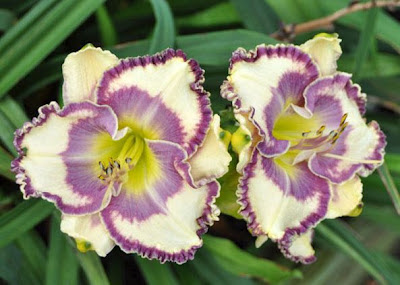"and ask myself
the rain question.
Why
Why
Why
Why....
Too much time on my hands or something.
This morning it is rainy. It's not the volume we need, but it's a tad more than nothing. Kathy and I bounded out of bed at 5:30, saw it wasn't raining yet, and dashed outside to gather pollen. The rain finally came. Between showers I took more daylily pictures. I like to document the way the flowers react to temperatures and also how they bloom differently from day to day.
This is Phil Korth's GRACE LIKE RAIN looking better than I've seen it in the bast three years and probably looking best with raindrops all over it.
Nearby is the kind of chalky white daylily I prefer above other shades of white. This is Patrick Stamile's WHITE MOUNTAIN.
This is is Larry Grace's BLUEGRASS MUSIC. When I felt the rain begin to fall I grabbed the only blossom I'll see this year and brought it inside to collect the pollen. Why only one flower? There's some kind of malaise affecting how the daylilies grow, and many think the oddities are related to the mood swings of our weather gods this year.
The background on this flower is some sort of off-white. The shades of blue and the pattern are what I love about this flower.
The strongest color in my entire collection belongs to David Kirchhoff's BETTY FORD, a strong contender for the top award this year and one of the best reds by the reigning master breeder of red daylilies.
In the vicinity is OBOE D'AMORE by Mort Morss (pictured below). The large warm center of this daylily evokes memories of the warm center in the tone of the oboe d'amore, which makes this daylily a strong marker for the remembered sound, just as David Kirchhoff's MARIA CALLAS has a quality of color easily as rich and complex as the sound of Maria Callas at her best.
Here's a daylily that almost never opens well in my garden, but did a passable job this morning, and which has a color that is really a study in unreconciled genetic conflicts. It's REGGIE MORGAN by Ted Petit and its complexities are the main reason for breeding with it. If I weren't a hybridizer, I wouldn't grow this daylily because the weather here seems to inhibit full, flat opening most of the time.
A much better Ted Petit daylily in my garden, virtually perfect every day, is OCEANS ELEVEN. I can't imagine ever tiring of this one. I remember a poem of Rubert Brooke that begins, "O, Death will find me long before I tire/ Of watching you..."
Try to imagine OCEANS ELEVEN as a pastel yellow flower, just try. The recent weather has prompted the advance of "melon" tones within the color of this one, giving the pastel yellow a toasty look.
Speaking of blue centers, you may notice concentric zones of bluish color on the face of OCEANS ELEVEN. I see them today also in the eye of Mort Morss's BUTTERFLIES ARE FREE, which is coming into its own as the plant adds mass.
If the weather "toasted" the pastel color of OCEAN'S ELEVEN, it ramped up the furnace warmth in the orange of Bill Maryott's OKTOBERFEST, which is an eye-catcher in any quality of color it displays.
Another quality of daylily color is called "polychrome," which involves blends of yellow, cream, gold, and pink, though not always on the same flower. Curt Hanson's THE GOLDILOCKS EFFECT is said by Curt to be the best polychrome. I don't believe he's being a huckster to say so. In my experience, Curt simply calls them as he sees them and is unashamed to announce which of his are the best. I love this one!
If you hybridize, this is a fantastic parent.
There's a unique daylily here named THE BAND PLAYED ON by Patrick Stamile. It's a rusty russet color with a black violet eye and edge. I go for very dark and mysterious flowers like this. My clump put up three scapes, all in bloom, so here are "The Three Tenors!"
Finally, back to blue purple and a fine example of the achievements of the late Ron Valente from Maine, CASCO BAY DELIGHT. On many mornings, this doesn't open fully until late in the morning, but this morning it was flat open when I went out at 6. I'm very glad I brought this into the collection. I doubt that Ron Valente ever registered an average daylily.










































